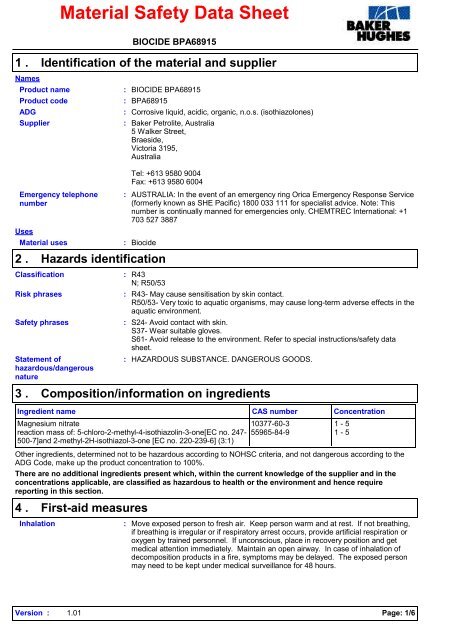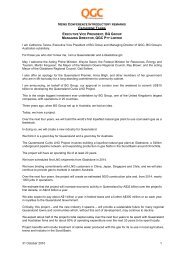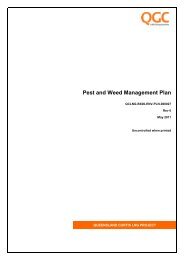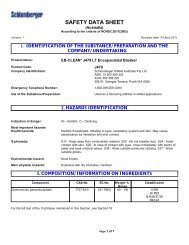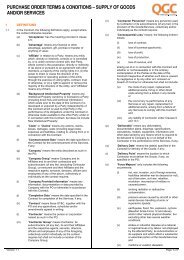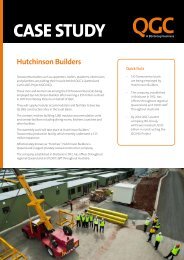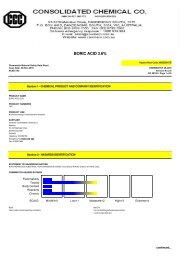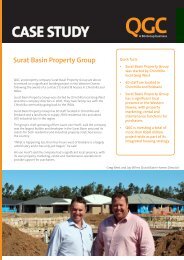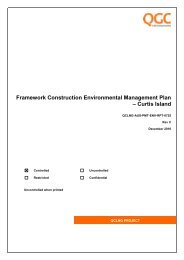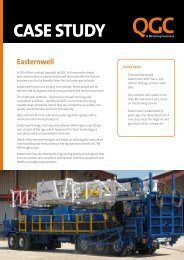Biocide BPA68915 - QGC
Biocide BPA68915 - QGC
Biocide BPA68915 - QGC
You also want an ePaper? Increase the reach of your titles
YUMPU automatically turns print PDFs into web optimized ePapers that Google loves.
Material Safety Data Sheet<br />
1 .<br />
Names<br />
Identification of the material and supplier<br />
Product name<br />
Product code :<br />
ADG :<br />
Supplier<br />
Emergency telephone<br />
number<br />
Uses<br />
Material uses<br />
2 .<br />
Classification<br />
Risk phrases<br />
:<br />
:<br />
:<br />
BIOCIDE <strong>BPA68915</strong><br />
BIOCIDE <strong>BPA68915</strong><br />
<strong>BPA68915</strong><br />
Corrosive liquid, acidic, organic, n.o.s. (isothiazolones)<br />
: Baker Petrolite, Australia<br />
5 Walker Street,<br />
Braeside,<br />
Victoria 3195,<br />
Australia<br />
Tel: +613 9580 9004<br />
Fax: +613 9580 6004<br />
AUSTRALIA: In the event of an emergency ring Orica Emergency Response Service<br />
(formerly known as SHE Pacific) 1800 033 111 for specialist advice. Note: This<br />
number is continually manned for emergencies only. CHEMTREC International: +1<br />
703 527 3887<br />
<strong>Biocide</strong><br />
Hazards identification<br />
Safety phrases<br />
Statement of<br />
hazardous/dangerous<br />
nature<br />
3 .<br />
:<br />
:<br />
:<br />
R43<br />
N; R50/53<br />
R43- May cause sensitisation by skin contact.<br />
R50/53- Very toxic to aquatic organisms, may cause long-term adverse effects in the<br />
aquatic environment.<br />
S24- Avoid contact with skin.<br />
S37- Wear suitable gloves.<br />
S61- Avoid release to the environment. Refer to special instructions/safety data<br />
sheet.<br />
: HAZARDOUS SUBSTANCE. DANGEROUS GOODS.<br />
Composition/information on ingredients<br />
Ingredient name CAS number Concentration<br />
Magnesium nitrate 10377-60-3 1 - 5<br />
reaction mass of: 5-chloro-2-methyl-4-isothiazolin-3-one[EC no. 247- 55965-84-9 1 - 5<br />
500-7]and 2-methyl-2H-isothiazol-3-one [EC no. 220-239-6] (3:1)<br />
Other ingredients, determined not to be hazardous according to NOHSC criteria, and not dangerous according to the<br />
ADG Code, make up the product concentration to 100%.<br />
There are no additional ingredients present which, within the current knowledge of the supplier and in the<br />
concentrations applicable, are classified as hazardous to health or the environment and hence require<br />
reporting in this section.<br />
4 .<br />
First-aid measures<br />
Inhalation :<br />
Move exposed person to fresh air. Keep person warm and at rest. If not breathing,<br />
if breathing is irregular or if respiratory arrest occurs, provide artificial respiration or<br />
oxygen by trained personnel. If unconscious, place in recovery position and get<br />
medical attention immediately. Maintain an open airway. In case of inhalation of<br />
decomposition products in a fire, symptoms may be delayed. The exposed person<br />
may need to be kept under medical surveillance for 48 hours.<br />
Version : 1.01<br />
Page: 1/6
BIOCIDE <strong>BPA68915</strong><br />
4 .<br />
Ingestion<br />
First-aid measures<br />
Skin contact<br />
Eye contact<br />
Protection of first-aiders<br />
Advice to doctor<br />
5 .<br />
Fire-fighting measures<br />
Suitable :<br />
Not suitable :<br />
Special exposure hazards :<br />
Hazardous thermal<br />
decomposition products<br />
Special protective<br />
equipment for fire-fighters<br />
Hazchem code<br />
6 .<br />
:<br />
:<br />
:<br />
:<br />
Wash out mouth with water. If material has been swallowed and the exposed<br />
person is conscious, give small quantities of water to drink. If vomiting occurs, the<br />
head should be kept low so that vomit does not enter the lungs. If unconscious,<br />
place in recovery position and get medical attention immediately. Maintain an open<br />
airway.<br />
Flush contaminated skin with plenty of water. Remove contaminated clothing and<br />
shoes. Wash contaminated clothing thoroughly with water before removing it, or<br />
wear gloves. Continue to rinse for at least 15 minutes. Get medical attention. In the<br />
event of any complaints or symptoms, avoid further exposure. Wash clothing before<br />
reuse. Clean shoes thoroughly before reuse.<br />
Immediately flush eyes with plenty of water, occasionally lifting the upper and lower<br />
eyelids. Check for and remove any contact lenses. Continue to rinse for at least 15<br />
minutes. Get medical attention if irritation occurs.<br />
: No action shall be taken involving any personal risk or without suitable training. It<br />
may be dangerous to the person providing aid to give mouth-to-mouth resuscitation.<br />
Wash contaminated clothing thoroughly with water before removing it, or wear<br />
gloves.<br />
In case of inhalation of decomposition products in a fire, symptoms may be delayed.<br />
The exposed person may need to be kept under medical surveillance for 48 hours.<br />
Use an extinguishing agent suitable for the surrounding fire.<br />
None known.<br />
Promptly isolate the scene by removing all persons from the vicinity of the incident if<br />
there is a fire. No action shall be taken involving any personal risk or without suitable<br />
training. This material is very toxic to aquatic organisms. Fire water contaminated<br />
with this material must be contained and prevented from being discharged to any<br />
waterway, sewer or drain.<br />
: Decomposition products may include the following materials:<br />
carbon dioxide<br />
carbon monoxide<br />
nitrogen oxides<br />
sulfur oxides<br />
halogenated compounds<br />
metal oxide/oxides<br />
: Fire-fighters should wear appropriate protective equipment and self-contained<br />
breathing apparatus (SCBA) with a full face-piece operated in positive pressure<br />
mode.<br />
: 2X<br />
Accidental release measures<br />
Personal precautions<br />
Environmental precautions<br />
Small spill<br />
:<br />
:<br />
No action shall be taken involving any personal risk or without suitable training.<br />
Evacuate surrounding areas. Keep unnecessary and unprotected personnel from<br />
entering. Do not touch or walk through spilt material. Avoid breathing vapour or<br />
mist. Provide adequate ventilation. Wear appropriate respirator when ventilation is<br />
inadequate. Put on appropriate personal protective equipment (see section 8).<br />
Avoid dispersal of spilt material and runoff and contact with soil, waterways, drains<br />
and sewers. Inform the relevant authorities if the product has caused environmental<br />
pollution (sewers, waterways, soil or air). Water polluting material. May be harmful<br />
to the environment if released in large quantities.<br />
: Stop leak if without risk. Move containers from spill area. Dispose of via a licensed<br />
waste disposal contractor. Absorb with an inert dry material and place in an<br />
appropriate waste disposal container.<br />
Version : 1.01<br />
Page: 2/6
BIOCIDE <strong>BPA68915</strong><br />
6 .<br />
Large spill<br />
Accidental release measures<br />
: Stop leak if without risk. Move containers from spill area. Approach the release<br />
from upwind. Prevent entry into sewers, water courses, basements or confined<br />
areas. Wash spillages into an effluent treatment plant or proceed as follows.<br />
Contain and collect spillage with non-combustible, absorbent material e.g. sand,<br />
earth, vermiculite or diatomaceous earth and place in container for disposal<br />
according to local regulations (see section 13). Dispose of via a licensed waste<br />
disposal contractor. Contaminated absorbent material may pose the same hazard<br />
as the spilt product. Note: see section 1 for emergency contact information and<br />
section 13 for waste disposal.<br />
7 .<br />
Handling and storage<br />
Storage<br />
:<br />
Store in accordance with local regulations. Store in original container protected from<br />
direct sunlight in a dry, cool and well-ventilated area, away from incompatible<br />
materials (see section 10) and food and drink. Keep container tightly closed and<br />
sealed until ready for use. Containers that have been opened must be carefully<br />
resealed and kept upright to prevent leakage. Do not store in unlabelled containers.<br />
Use appropriate containment to avoid environmental contamination.<br />
8 .<br />
Exposure controls/personal protection<br />
Occupational exposure limits<br />
Ingredient name<br />
Exposure limits<br />
Magnesium nitrate SWA (Australia, 8/2005).<br />
TWA: 1 mg/m³, (as Mn) 8 hour(s). Form: Dust<br />
Recommended monitoring<br />
procedures<br />
Engineering measures<br />
Hygiene measures<br />
Eyes<br />
Hands<br />
Respiratory<br />
Skin<br />
Environmental exposure<br />
controls<br />
: If this product contains ingredients with exposure limits, personal, workplace<br />
atmosphere or biological monitoring may be required to determine the effectiveness<br />
of the ventilation or other control measures and/or the necessity to use respiratory<br />
protective equipment.<br />
:<br />
:<br />
:<br />
:<br />
:<br />
:<br />
No special ventilation requirements. Good general ventilation should be sufficient to<br />
control worker exposure to airborne contaminants. If this product contains<br />
ingredients with exposure limits, use process enclosures, local exhaust ventilation or<br />
other engineering controls to keep worker exposure below any recommended or<br />
statutory limits.<br />
Wash hands, forearms and face thoroughly after handling chemical products, before<br />
eating, smoking and using the lavatory and at the end of the working period. Wash<br />
contaminated clothing before reusing. Ensure that eyewash stations and safety<br />
showers are close to the workstation location.<br />
Safety eyewear complying with an approved standard should be used when a risk<br />
assessment indicates this is necessary to avoid exposure to liquid splashes, mists or<br />
dusts.<br />
Chemical-resistant, impervious gloves complying with an approved standard should<br />
be worn at all times when handling chemical products if a risk assessment indicates<br />
this is necessary.<br />
Use a properly fitted, air-purifying or air-fed respirator complying with an approved<br />
standard if a risk assessment indicates this is necessary. Respirator selection must<br />
be based on known or anticipated exposure levels, the hazards of the product and<br />
the safe working limits of the selected respirator.<br />
Personal protective equipment for the body should be selected based on the task<br />
being performed and the risks involved and should be approved by a specialist<br />
before handling this product.<br />
: Emissions from ventilation or work process equipment should be checked to ensure<br />
they comply with the requirements of environmental protection legislation. In some<br />
cases, fume scrubbers, filters or engineering modifications to the process equipment<br />
will be necessary to reduce emissions to acceptable levels.<br />
Version : 1.01<br />
Page: 3/6
BIOCIDE <strong>BPA68915</strong><br />
9 .<br />
Physical state<br />
Colour<br />
Odour<br />
Physical and chemical properties<br />
Relative density<br />
pH<br />
:<br />
Solubility :<br />
10 .<br />
Chemical stability<br />
Conditions to avoid<br />
Materials to avoid<br />
Hazardous decomposition<br />
products<br />
:<br />
:<br />
Liquid.<br />
Grey. / Yellow.<br />
: Characteristic.<br />
: 1.03 (20°C)<br />
:<br />
:<br />
:<br />
:<br />
3 to 5<br />
Soluble in water.<br />
Stability and reactivity<br />
Possibility of hazardous<br />
reactions<br />
11 .<br />
The product is stable.<br />
: Under normal conditions of storage and use, hazardous reactions will not occur.<br />
Avoid release to the environment. Refer to special instructions/safety data sheet.<br />
No specific data.<br />
Toxicological information<br />
Potential acute health effects<br />
Inhalation<br />
Ingestion<br />
Skin contact<br />
Eye contact<br />
Potential chronic health effects<br />
:<br />
:<br />
:<br />
:<br />
Under normal conditions of storage and use, hazardous decomposition products<br />
should not be produced.<br />
Exposure to decomposition products may cause a health hazard. Serious effects<br />
may be delayed following exposure.<br />
No known significant effects or critical hazards.<br />
May cause sensitisation by skin contact.<br />
No known significant effects or critical hazards.<br />
Acute toxicity<br />
Product/ingredient name Result Species Dose Exposure<br />
Magnesium nitrate LD50 Oral Rat 5440 mg/kg -<br />
reaction mass of: 5-chloro-2- LD50 Oral Rat 53 mg/kg -<br />
methyl-4-isothiazolin-3-<br />
one[EC no. 247-500-7]and<br />
2-methyl-2H-isothiazol-3-one<br />
[EC no. 220-239-6] (3:1)<br />
Conclusion/Summary : Not available.<br />
Chronic toxicity<br />
Conclusion/Summary<br />
Irritation/Corrosion<br />
Conclusion/Summary<br />
Sensitiser<br />
Conclusion/Summary<br />
Carcinogenicity<br />
Conclusion/Summary<br />
Mutagenicity<br />
Conclusion/Summary<br />
Teratogenicity<br />
: Not available.<br />
: Not available.<br />
: Not available.<br />
: Not available.<br />
: Not available.<br />
Conclusion/Summary<br />
Reproductive toxicity<br />
Conclusion/Summary<br />
Chronic effects<br />
Carcinogenicity<br />
Mutagenicity<br />
Teratogenicity<br />
: Not available.<br />
: Not available.<br />
: Once sensitized, a severe allergic reaction may occur when subsequently exposed<br />
to very low levels.<br />
:<br />
:<br />
:<br />
No known significant effects or critical hazards.<br />
No known significant effects or critical hazards.<br />
No known significant effects or critical hazards.<br />
Version : 1.01<br />
Page: 4/6
BIOCIDE <strong>BPA68915</strong><br />
11 .<br />
Inhalation<br />
Ingestion<br />
Skin<br />
Target organs<br />
Toxicological information<br />
Developmental effects<br />
Fertility effects<br />
Eyes<br />
12 .<br />
Ecotoxicity<br />
:<br />
:<br />
:<br />
:<br />
:<br />
:<br />
No known significant effects or critical hazards.<br />
No known significant effects or critical hazards.<br />
No specific data.<br />
No specific data.<br />
Adverse symptoms may include the following:<br />
irritation<br />
redness<br />
: No specific data.<br />
Ecological information<br />
Aquatic ecotoxicity<br />
Conclusion/Summary : Not available.<br />
Other ecological information<br />
Persistence/degradability<br />
Conclusion/Summary<br />
Other adverse effects<br />
13 .<br />
Methods of disposal<br />
14 .<br />
Contains material which may cause damage to the following organs: upper<br />
respiratory tract, skin, eyes.<br />
: Very toxic to aquatic organisms, may cause long-term adverse effects in the aquatic<br />
environment.<br />
: Not available.<br />
Disposal considerations<br />
Transport information<br />
: No known significant effects or critical hazards.<br />
: This material and its container must be disposed of in a safe way. Dispose of<br />
surplus and non-recyclable products via a licensed waste disposal contractor.<br />
Disposal of this product, solutions and any by-products should at all times comply<br />
with the requirements of environmental protection and waste disposal legislation and<br />
any regional local authority requirements. Avoid dispersal of spilt material and runoff<br />
and contact with soil, waterways, drains and sewers.<br />
Regulation UN number Proper shipping name Classes PG*<br />
ADG<br />
UN3265<br />
Corrosive liquid, acidic,<br />
organic, n.o.s.<br />
(isothiazolones)<br />
8 III<br />
Label<br />
Additional information<br />
Hazchem code<br />
2X<br />
ADR UN3265 Corrosive liquid, acidic,<br />
organic, n.o.s.<br />
(isothiazolones)<br />
8 III<br />
UK Hazchem: 2X<br />
IMDG UN3265 Corrosive liquid, acidic, 8 III<br />
organic, n.o.s.<br />
(isothiazolones)<br />
-<br />
IATA UN3265 Corrosive liquid, acidic, 8 III<br />
organic, n.o.s.<br />
(isothiazolones)<br />
-<br />
PG* : Packing group<br />
Version : 1.01<br />
Page: 5/6
BIOCIDE <strong>BPA68915</strong><br />
15 .<br />
Regulatory information<br />
Standard for the Uniform Scheduling of Drugs and Poisons<br />
Not regulated.<br />
Control of Scheduled Carcinogenic Substances<br />
Ingredient name<br />
No listed substance<br />
Australia inventory (AICS)<br />
EU Classification :<br />
HCS Classification<br />
Risk phrases<br />
Safety phrases<br />
National regulations<br />
16 .<br />
Disclaimer<br />
Other information<br />
: All components are listed or exempted.<br />
:<br />
R43<br />
N; R50/53<br />
Date of printing : 8/2/2010.<br />
Date of issue/ Date of<br />
revision<br />
Date of previous issue<br />
Version<br />
Toxic material<br />
Irritating material<br />
Carcinogen<br />
Target organ effects<br />
Schedule<br />
: R43- May cause sensitisation by skin contact.<br />
R50/53- Very toxic to aquatic organisms, may cause long-term adverse effects in the<br />
aquatic environment.<br />
:<br />
S24- Avoid contact with skin.<br />
S37- Wear suitable gloves.<br />
S61- Avoid release to the environment. Refer to special instructions/safety data<br />
sheet.<br />
: National Code of Practice for the Control of Workplace Hazardous Substances.<br />
National Code of Practice for the Labelling of Workplace Substances. National<br />
Code of Practice for the Preparation of Material Safety Data Sheets. Approved<br />
Criteria for Classifying Hazardous Substances.<br />
:<br />
:<br />
:<br />
8/2/2010.<br />
No previous validation.<br />
1.01<br />
Indicates information that has changed from previously issued version.<br />
To the best of our knowledge, the information contained herein is accurate. However, neither the above-named<br />
supplier, nor any of its subsidiaries, assumes any liability whatsoever for the accuracy or completeness of the<br />
information contained herein.<br />
Final determination of suitability of any material is the sole responsibility of the user. All materials may present<br />
unknown hazards and should be used with caution. Although certain hazards are described herein, we cannot<br />
guarantee that these are the only hazards that exist.<br />
Version : 1.01<br />
Page: 6/6


